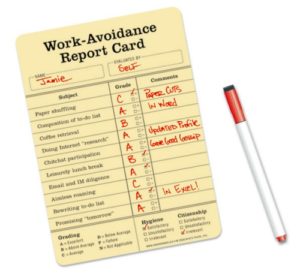Work Avoidance (and How to Avoid It)

Ever been in a meeting and wonder why you’re there? Chances are, you’re there because someone doesn’t want to work. The average meeting is an excellent way to pass the time without getting anything done, which, sadly, is exactly what some people want to accomplish. And now, the conference call has taken unproductive meetings to new heights, providing slackers with the opportunity to mute their phones and surf their social networking sites with impunity.
At today’s Results-Based Facilitation Workshop, sponsored by the Staten Island Foundation, not only did we learn proven strategies for facilitating productive meetings that move teams from talk to action, but also how to be a good meeting participant. It all starts with defining the purpose of the meeting, being clear about the roles of the participants, and staying within the boundaries of authority with respect to your role.
First, when planning the meting agenda, think about what you want to accomplish. When the meeting is adjourned, how will things be different? Is the purpose simply to inform or update people or get the to make action commitments? Are you trying to capture input for future decision-making, or will decisions be made in the meeting to inform a way forward? Will the team gain knowledge to improve their productivity and become more unified? Having a clearly articulated, intended result is an imperative for a productive meeting. Likewise, each activity/item on the agenda should also have an intended result.
Just a reminder, folks: we’re supposed to be discussing the pros and cons of bringing in an outside consultant and coming to a decision on whether that’s the best course. We’ve all had a choice to weigh in on this and we need to move on to the next agenda item, so I suggest we…(insert action commitment here – it could be taking a vote or deferring to the decider, but it’s a way out of the circular debate of the options and considerations.)
That said, don’t be married to your agenda. With the meeting’s purpose and intended result in mind, be flexible. As our facilitator told us, “results are the promise, the agenda is the possibility.” An agenda is a means towards achieving the meeting’s intended result, so if it’s not going well it’s better to switch it up than stick with something that’s not going to get you where you want to be.
Everyone has a role in the meeting (facilitator, attendee, moderator, observer, evaluator, consultant). Knowing your role, and sticking to it, is crucial to making that 60 minutes meaningful. For example, it is important for a facilitator to maintain neutrality. Rather than putting forth their own ideas, or making value judgments about the ideas of others, the facilitator’s role is to source input from the group – good, bad, or indifferent. Active listening is critical to any meeting role, as is putting personal biases and motivations aside. We’ve all sat in on meetings with the Interruptor, the Talk-a-Lotty, the Idea Bully, and the Rambler. These folks provide us with painful examples of what happens when meeting participants step outside of their roles, exceed the boundaries of their authority, and/or put their own agenda ahead of the intended result of the meeting.
I know that you have some strong views and really good ideas on what this program should ultimately look like, but right now we’re trying to decide on the overall structure of this partnership. It’s very likely that the structure will include a working group whose task will be to design and develop the program, and you will certainly play a big part in that. But for now, let’s focus on establishing agreed upon roles, responsibilities, lines of communication and accountability that will make the partnership a success.
It can be difficult to stop a rogue participant from derailing a meeting (and demoralizing everyone else in the room). Our facilitator gave us a simple but powerful reminder to share with your colleagues that can help to keep your meetings on track:
“Brevity is a leadership skill.”
For more on results-based facilitation, take a look at this super-fantastic workbook by Jolie Bain Pillsbury, Ph.D.







